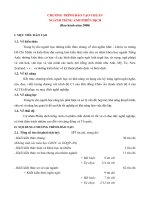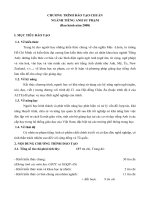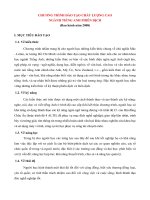THUYẾT TRÌNH ĐẠO HÀM BẰNG TIẾNG ANH DERIVATIVES
Bạn đang xem bản rút gọn của tài liệu. Xem và tải ngay bản đầy đủ của tài liệu tại đây (3.81 MB, 42 trang )
VDERIVATIVESE
Instructors : …
Presentation group 4: ….
Want big impact?
USE BIG IMAGE.
ISAAC NEWTON
and
GOTTFRIED LEIBINZ
were scientist who invented
derivatives, integrals and
differentials
2
6. THE SECOND DERIVATIVE
3. DERIVATIVE OF SUM,
1. DERIVATIVE AT A POINT
DIFFERENCE, PRODUCT AND
QUOTIENT
DERIVATIVES
2. DERIVATIVES OF SOME
4. DERIVATIVE OF A
COMMON FUNCTIONS
COMPOSSITE FUNCTION
5. DERIVATIVE OF A
TRIGONOMETRIC FUNCTION
3
I. Definition of a derivative at a point
1. Definition
▹
Given
function
defined on the open interval (a;b) and
Derivative : đạo hàm
If there exists (finite) limit
Defined: được xác định
Then the limit is called a derivative of a function
Interval: khoảng
Exists: tồn tại
at point and denoted by
or namely,
Finite: hữu hạn
Point: điểm
.
Namely: tức là
4
▹
NOTE
Quantity is called the increment of argument at
“
Quantity
is called the corresponding increment of the function. Thus,
Quantity: đại lượng
Corresponding increment: số gia tương ứng
Increment: số gia
Argument: đối số
Thus: như vậy
5
2. How to calculate a derivative by definition
Rule:
Step 1: Let be the increment of an argument at
Calculate:
Step 2: Form ratio
⊷Step 3: Find
Calculate: tính
Form: lập
Ratio: tỉ số, tỉ lệ
6
Example 1. Calculate the derivative of function
at
point
▹
Solution:
Let be the increment of an argument at . We have:
divided by x, we shall show:
Then,
Therefore,
7
Example 2. Calculate the derivative of function
at point
▹
Solution:
Let be the increment of an argument at . We have:
divided by x, we shall show:
Then,
Therefore,
8
II. Derivativers of some common functions
Theorem 1: Function has
a derivative at every and
Theorem 2: Function has a derivative at every positive x and
9
Theorem: định lí
Example 1. Find the dervative of function
▹
Remax
a) Derivative of a constant function equals 0
a)
b) Derivative of function
b)
Remax: nhận xét
Constant function: hàm hằng
10
y = x equals 1
III. Derivative of sum, difference, product and quotient
1. Theorem
Theorem 3: Suppose u = u(x) and v = v(x) are functions with derivatives at point x on the defined interval. We have
(u + v )′ = u ′ + v′
(u − v )′ = u ′ − v′
(uv)′ = u ′v + uv′
′
u ′v − uv′
u
(v = v ( x) ≠ 0)
=
2
v
v
11
1
2
3
4
Quotient: thương
Suppose: giả sử
Defined interval: khoảng xác định
Example 1. Find the dervative of function
Solution
a) We have
a)
b) Do it yourseft
c) Do it yourseft
b)
c)
12
b) We have:
[x (
3
c) We have:
] ( )
′
′
x − x ) = x 3 ( x − x 5 ) + x 3 ( x − x 5 )′
5
1
= 3 x 2 ( x − 5) + x 3
− 5x 4
2 x
1
=
3x 2 x + x 3
− 8x 4
2 x
′
x
4
3
4
x
−
=
16
x
−x
2
2
13
2. Corollary
Corollary 1: If is a constant, then
′
v′
1
=
−
v2
v
Corollary 2:
( ku )′ = ku ′
Example 3. Find the dervative of function
a)
y=
1 − 2x
x+3
Solution: We have
′
′
(
1 − 2 x ) ( x + 3) − (1 − 2 x )( x + 3)′
1− 2x
=
( x + 3) 2
x+3
=
− 2( x + 3) − (1 − 2 x)
−7
=
( x + 3) 2
( x + 3) 2
14
Example 2: Find the derivative of function
a)
b)
3 − 5x
y= 2
x − x +1
2x +1
y=
x4
′
(3 − 5 x)′( x 2 − x + 1) + (3 − 5 x )( x 2 − x + 1)
3 − 5x
2
÷=
( x 2 − x + 1) 2
x − x +1
2
′
2
−
15
x
8 + (3 − 5 x)( x 2 − x + 1)
3
−
5
x
(3
−
5
x
)′(+x16
−xx −
+ 1)
2
÷ =
( x 2 − x + 1()x2 2 − x + 1) 2
x − x +1
′
2
x
+
1
( 2 x + 1)′ x 4 + ( 2 x + 1)( x 4 )′
=
4
4 2
x
(
x
)
4 2
3
′
(3 − 5x
x )′( x+
−4
x +x1) + (3 − 5 x)( x 2 − x + 1)
3 − 5 x 10
2
÷=
x − x +1
x 8 ( x 2 − x + 1)2
15
IV. Derivative of a composite function
Theorem 4. If function has derivative at x and function has derivative at , then composite function has a
derivative at
y′x = yu′ .u ′x
composite function: hàm hợp
16
Example 1: Find the derivative of function
17
V. Derivative of function
Theorem 1: Function y=sinx has derivative at every and
Theorem 2: Function y=cosx has derivative at every and
Theorem 3: Function y=tanx has derivative at every and
Theorem 4: Function y=cotx has derivative at every and
Example 1: Find the derivative of function
Solution:
Setting , it follows that u’=3 and
We have
Example 2: Find the derivative of function
Solution:
Setting 5, it follows that and
We have
? Exercise 1: Find the derivative of function
?
Exercise 2: Find the derivative of function
19
VI. THE SECOND DERIVATIVE
1. DEFINITION
▹Assume
function has a derivative at every point . Then, relation defines a new function on the interval
(a;b). If function has another derivative at , then we call the derivative of function is the second
derivative of function at and denoted by or
20
2. NOTE
The third derivative of function is defined similarly and denoted by of or .
th
Given function with the n-1 derivative and denoted by.
If has a derivative, then its derivative is called the derivative of and denoted by or
.
th
Example 1: Find the second derivative and the n derivative of the follwing functions:
a)
b) y = x
Solution
Do it yourseft
If y = then
n
y = 0 with n>5
22
GAME RULES
THREE GROUPS WILL PARTICIPATE IN A THREE - PART GAME:
1. Starting up
2. Acceleration
3. To the finish line
At the end of the 3 sessions, the team with the highest total score will win and win a prize.
When one team participates in the game, the other 2 teams will act as judges and the secretary will sum up
the points for each group.
STArTING UP
RULE:
There are 3 question packs, each with 30 seconds of thinking and answering
time. Each correct answer is added 5 points to the group’s score bank. If you
answer incorrectly, you will receive no points.
At the end of the 3 - pack questioning which group is the highest, that group
wins in this game.
STArTING UP
1
2
3
Select the questionnaire package









